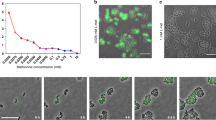Abstract
WhenEscherichia coli strain AB1157 is subjected to starvation for threonine or leucine on solid media, threonine-independent or leucine-independent colonies continue to emerge for several days after plating. This process is strongly streptomycin dependent. Under identical conditions arginine-independent colonies do not arise when arginine starvation is imposed. Since thethr1 andleuB6 alleles of AB1157 could be classified as ‘leaky’ while theargE3 allele cannot be so classified, there seems to be a correlation between leakiness of mutant genetic markers and post-plating mutagenesis which counters the effect of the mutations. Some of the threonine-independent variants acquired the ability to increase the leakiness of otherwise nonleaky markers such asargE3 and permit development of arginine independence in arecA-dependent,lexA-independent manner. I show that these variants harbour a mutation, tentatively namedadi (adaptation inducer), at around 72 min on the genetic map, and that theadi mutation increases the intrinsic leakiness of alacZ (ochre) mutation, perhaps by enhanced translational error. These observations are discussed in relation to the phenomenon of ‘adaptive’ mutagenesis, its possible mechanism, and its specificity.
Similar content being viewed by others
References
Cairns J. and Foster P. L. 1991 Adaptive reversion of a framcshift mutation inEscherichia coli.Genetics 128: 695–701
Cairns J., Overbaugh J. and Miller S. 1988 The origin of mutants.Nature 355: 142–145
Cavalli-Sforza L. L. and Lederberg J. 1956 Isolation of preadaptive mutants by sib selection.Genetics 41: 367–381
Culotta E. 1994 A boost for “adaptive” mutation.Science 265: 318–319
Fijalkowska I. J., Dunn R. L. and Schaaper R. M. 1993 Mutants ofEscherichia coli with increased fidelity of DNA replication.Genetics 134: 1023–1030
Fijalkowska I. J. and Schaaper R. M. 1993 Antimutator mutations in the α-subunit ofEscherichia coli DNA polymerase III: Identification of the responsible mutations and alignment with other DNA polymerases.Genetics 134: 1039–1044
Foster P. L. 1992 Directed mutation: Between unicorns and goats.J. Bacteriol. 174: 1711–1716
Foster P. L. 1993 Adaptive mutation: The uses of adversity.Annu. Rev. Microbiol. 47: 467–504
Foster P. L. and Cairns J. 1994 The occurrence of heritable Mu excisions in starving cells ofEscherichia coli.EMBO J. 13: 5240–5244
Foster P. L. and Trimarchi J. M. 1994 Adaptive reversion of a frameshift mutation inEscherichia coli by simple base deletions in homopolymeric runs.Science 265: 407–409
Hall B. G. 1990 Spontaneous point mutations that occur more often when advantageous than when neutral.Genetics 126: 5–16
Hall B. G. 1995 Genetics of selection-induced mutations: I.uvrA, uvrB, uvrC and uvrD are selection-induced specific mutator loci.J. Mol. Evol. 40: 86–93
Harris R. S., Longerich S. and Rosenberg S. M. 1994 Recombination in adaptive mutation.Science 264: 258–260
Jayaraman R. 1992 Cairnsian mutagenesis inEscherichia coli: Genetic evidence for two pathways regulated bymutS andmutL genes.J. Genet. 71: 23–41
Keller E. F. 1992 Between language and science. The question of directed mutation in molecular genetics.Perspect. Biol. Med. 35: 292–306
Lederberg J. and Lederberg E. M. 1952 Replica plating and indirect selection of mutants.J. Bacteriol. 63: 399–406
Lenski R. E. and Mittler J. E. 1993 The directed mutation controversy and neo-Darwinism.Science 259: 188–194
Lenski R. E., Slatkin M. and Ayala F. J. 1989 Mutation and selection in bacterial populations.Proc. Natl. Acad. Sci. USA 86: 2775–2778
Luria S. E. and Delbrück M. 1943 Mutations of bacteria from virus sensitivity to virus resistance.Genetics 28: 491–513
MacPhee D. G. 1993 Is there evidence for directed mutation in bacteria?Mutagenesis 8: 3–5
Maenhaut-Michel G. and Shapiro J. A. 1994 The roles of starvation and selective substrates in the emergence ofaraB-lacZ fusion clonesEMBO J. 13: 5229–5239
Maki H., Mo J. Y. and Sekiguchi M. 1991 A strong imitator effect caused by an amino acid change in the alpha subunit of DNA polymerase III ofEscherichia coli.J. Biol. Chem. 266: 5055–5061
Maruyama M., Horiuchi H., Makai H. and Sekiguchi M. 1983 A dominant (mutD5) and a recessive (dnaQ49) mutator ofEscherichia coli.J. Mol. Biol. 167: 757–771
Mittler J. E. and Lenski R. E. 1992 Experimental evidence for an alternative to directed mutation in thebgl operon.Nature 356: 446–448
Modrich P. 1987 DNA mismatch correction.Annu. Rev. Biochem. 56: 435–466
Radman M. and Wagner R. 1986 Mismatch repair inEscherichia coli.Annu. Rev. Genet. 20: 523–538
Rosenberg S. M., Longerich S., Gee P. and Harris R. S. 1994 Adaptive mutations by deletions in small mononucleotide repeats.Science 265: 405–407
Sarkar S. 1991 Lamarck contre Darwin, reduction versus statistics: Conceptual issues in the controversy over directed mutagenesis in bacteria. In:Organism and the origin of self (ed.) A. I. Tauber (Dordrecht: Kluwer Academic) pp. 235–271
Schaaper R. M. 1993 The mutational specificity of twoEscherichia coli dnaE antimutator alleles as determined fromlacl mutation spectra.Genetics 134: 1031–1038
Schaaper R. M. and Cornacchio R. 1992 AnEscherichia coli dnaE mutation with suppressor activity towards mutatormutD5.J. Bacteriol. 174: 1974–1982
Shapiro J. A. 1984 Observations on the formation of clones containingaraB-lacZ cistron fusions.Mol. Gen. Genet. 194: 79–90
Sniegowski P. D. 1995 The origin of adaptive mutants: random or nonrandom?J. Mol. Evol. 40: 94–101
Stahl F. W. 1992 Unicorns revisited.Genetics 132: 865–867
Thaler D. S. 1994 The evolution of genetic intelligence.Science 264: 224–225
Tokano K., Nakabeppu Y., Makai H., Horuchi J. and Sekiguchi M. 1986 Structure and function ofdnaQ andmutD mutators ofEscherichia coli.Mol. Gen. Genet. 205: 9–13
Wu T. T. 1966 A model for three point analysis of random general transduction.Genetics 55: 405–410
Yarus M. and Thompson R. C. 1983 Precision of protein biosynthesis. In:Gene function in prokaryotes (eds.) J. Beckwith., J. Davies and J. A. Gallant (Cold Spring Harbor: Cold Spring Harbor Laboratory Press) pp. 23–63
Author information
Authors and Affiliations
Rights and permissions
About this article
Cite this article
Jayaraman, R. Leakiness of genetic markers and susceptibility to post-plating mutagenesis inEscherichia coli . J. Genet. 74, 85–97 (1995). https://doi.org/10.1007/BF02932195
Received:
Revised:
Issue Date:
DOI: https://doi.org/10.1007/BF02932195




